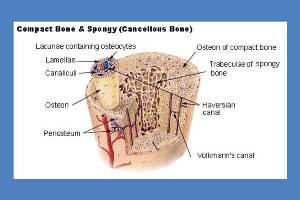How Are Bones Made and How Do They Grow?
 Each of the 206 bones in your body is constantly undergoing a process of breakdown and renewal, even if you have never suffered a broken bone in your life. Your entire skeleton is completely replaced approximately every 10 years. The construction of bone tissue begins when we are a fetus in the womb, and continues until we die. Our genetics and both the nutrients we receive before we are born and those we get through our diet in our youth have a major influence on the strength and endurance of our skeletal system.
Each of the 206 bones in your body is constantly undergoing a process of breakdown and renewal, even if you have never suffered a broken bone in your life. Your entire skeleton is completely replaced approximately every 10 years. The construction of bone tissue begins when we are a fetus in the womb, and continues until we die. Our genetics and both the nutrients we receive before we are born and those we get through our diet in our youth have a major influence on the strength and endurance of our skeletal system.
Fetal cartilage is the precursor to bone growth, and is transformed into bone in a process called ossification. The fetal cartilage attracts the minerals calcium and phosphorus, which cover the cartilage cells. The fetal cartilage cells soon die off, leaving small holes through which blood vessels can grow. Osteoblasts, the specialized cells responsible for bone growth, travel to the developing bone via these tiny blood vessels. There they produce the collagen fibers that are the structure over which bone is formed, and attract the calcium with which the fibers are covered. Osteoblasts eventually transform into osteocytes, which become part of the calcium mix that helps to reinforce the collagen fibers and strengthen the bone.
Osteoclasts are the cells responsible for breaking down and removing old bone tissue, leaving small chambers that allow marrow to form. The small holes osteoclasts create are why this particular part of the bone is called spongy bone. Although it is hard, spongy bone resembles a common kitchen sponge. In our youth, the osteoblasts outnumber the osteoclasts, so we have a net gain of bone growth. This is when the growth of bone is referred to as modeling. Bone continues to grow until approximately our mid-20s, at which point we have reached our greatest bone density.
From our mid-20s on, our bones are in a constant process of remodeling. At this point, the osteoblasts can no longer keep up with the osteoclasts. While bone is continually being rebuilt, no supplemental bone is being added, so we can begin to lose bone density. Even though our bodies no longer add to our stock of spongy bone tissue after our mid-20s, we can still continue to add bone to the outer layer of our bones, called compact bone. Compact bone accounts for about 80 percent of our bone mass and protects the more fragile spongy bone inside. Although compact bone is considerably denser than spongy bone, it still has tiny channels for blood vessels and nerves to pass through.
Our spongy bone is filled with two types of marrow, red and yellow. Red bone marrow is responsible for the creation of our red and white blood cells and the platelets that are necessary for clotting in order to stop bleeding when we are injured. Yellow bone marrow consists mostly of fat cells and is more common in our long bones, such as the femur.
A healthy diet with adequate amounts of calcium, magnesium, phosphorus and vitamin K, along with a little regular weight-bearing exercise, will help ensure that you maintain the greatest bone density possible as you age, and will help protect against the danger of fractures due to osteoporosis.